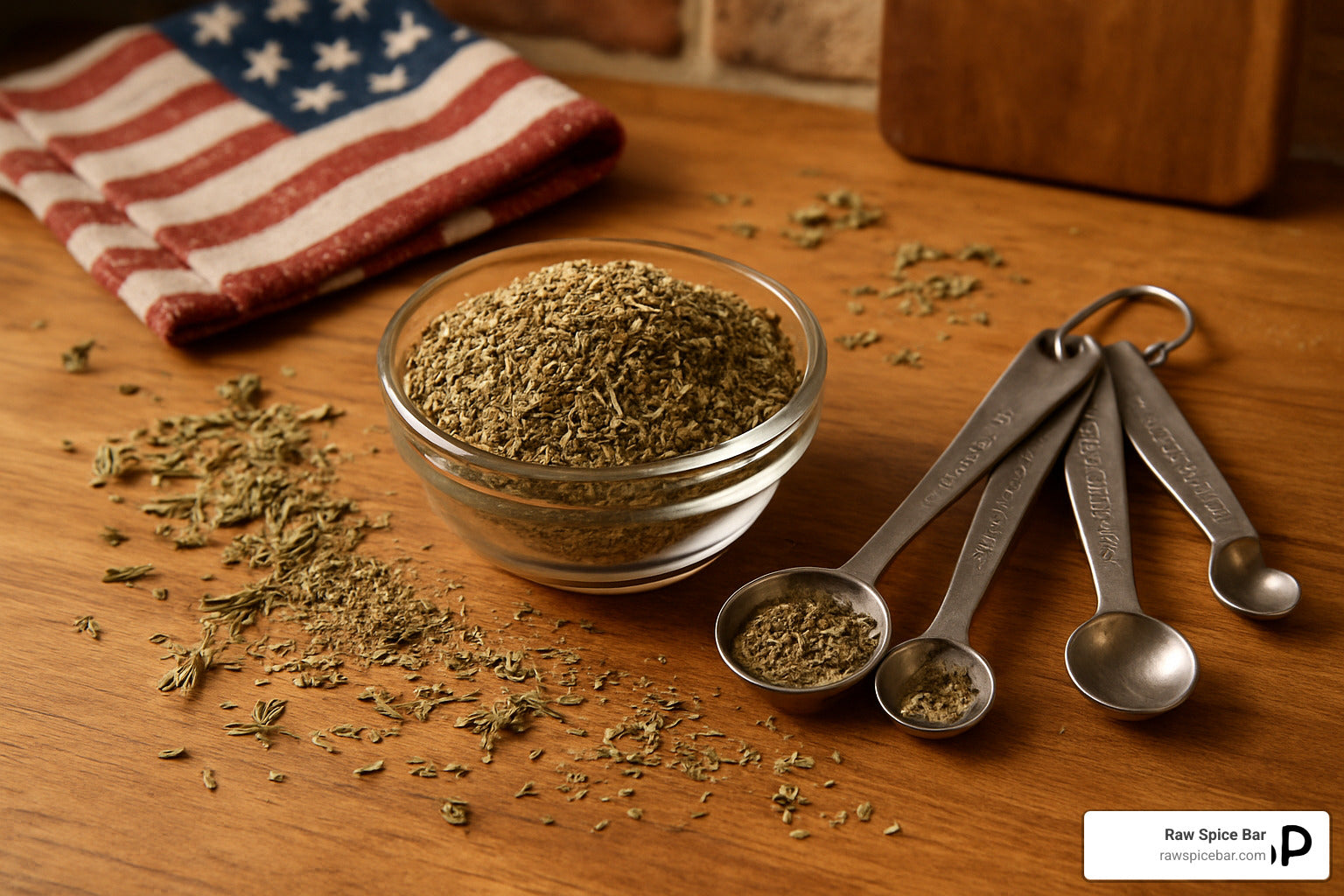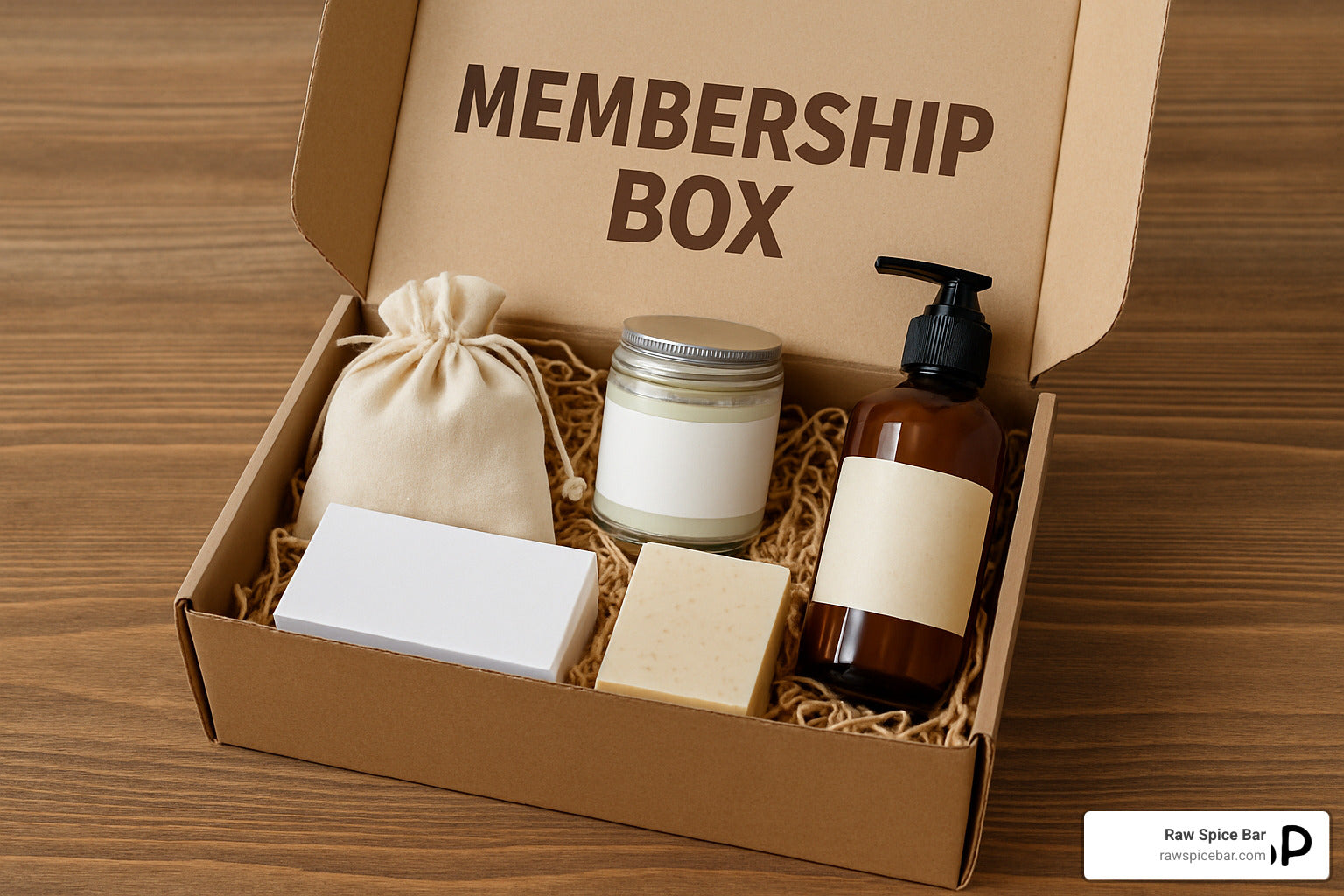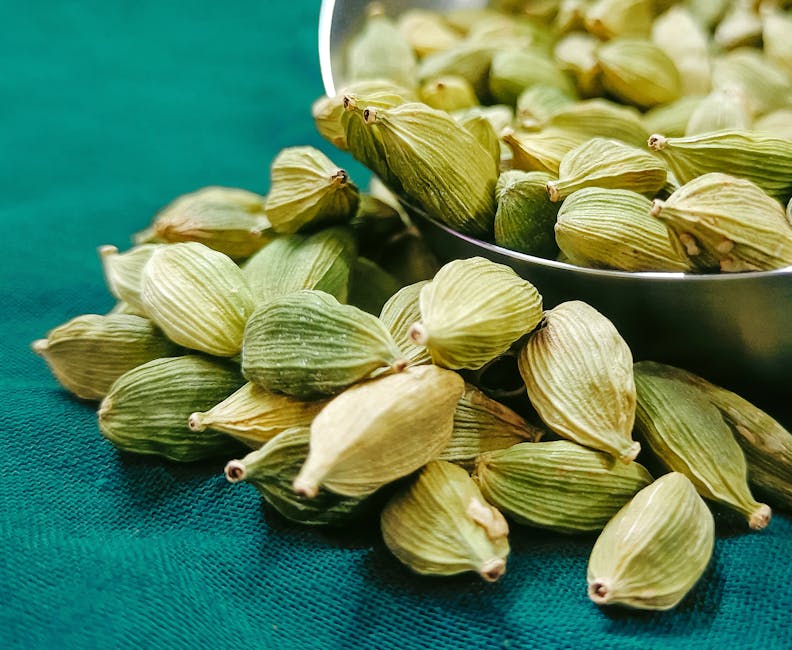Why Learning How to Use Spices Will Transform Your Cooking
How to use spices is the fastest way to make everyday cooking exciting, healthier, and more creative. Master just a handful of principles and you can:
• Start small – add a pinch, taste, repeat
• Toast first – a quick dry-pan toast wakes up sleepy spices
• Store smart – airtight, cool, dark, and far from the stove
• Buy fresh – ground = 6 mo, whole = 18 mo
• Layer flavors – hardy spices early, delicate ones at the end
• Lean on classics – cumin + coriander, cinnamon + cardamom, etc.
Think of spices as an artist’s paint: a single dash of turmeric turns rice sunset-gold, a pinch of smoked paprika gives plain potatoes camp-fire depth. Once you get comfortable, you’ll notice your need for salt drops, your kitchen smells amazing, and your food never tastes “the same” two nights in a row.
Spices also connect us to global stories. Centuries-old trade routes, family memories of Grandma’s cinnamon rolls, or the first whiff of garam masala from an Indian market – it’s all right there in the jar.
I’m Joseph Rosenblatt, founder of Raw Spice Bar. After years of blending and teaching, I’ve learned that the true hurdle isn’t finding good spices; it’s knowing how to use spices with confidence. The rest of this guide will get you there quickly and safely.
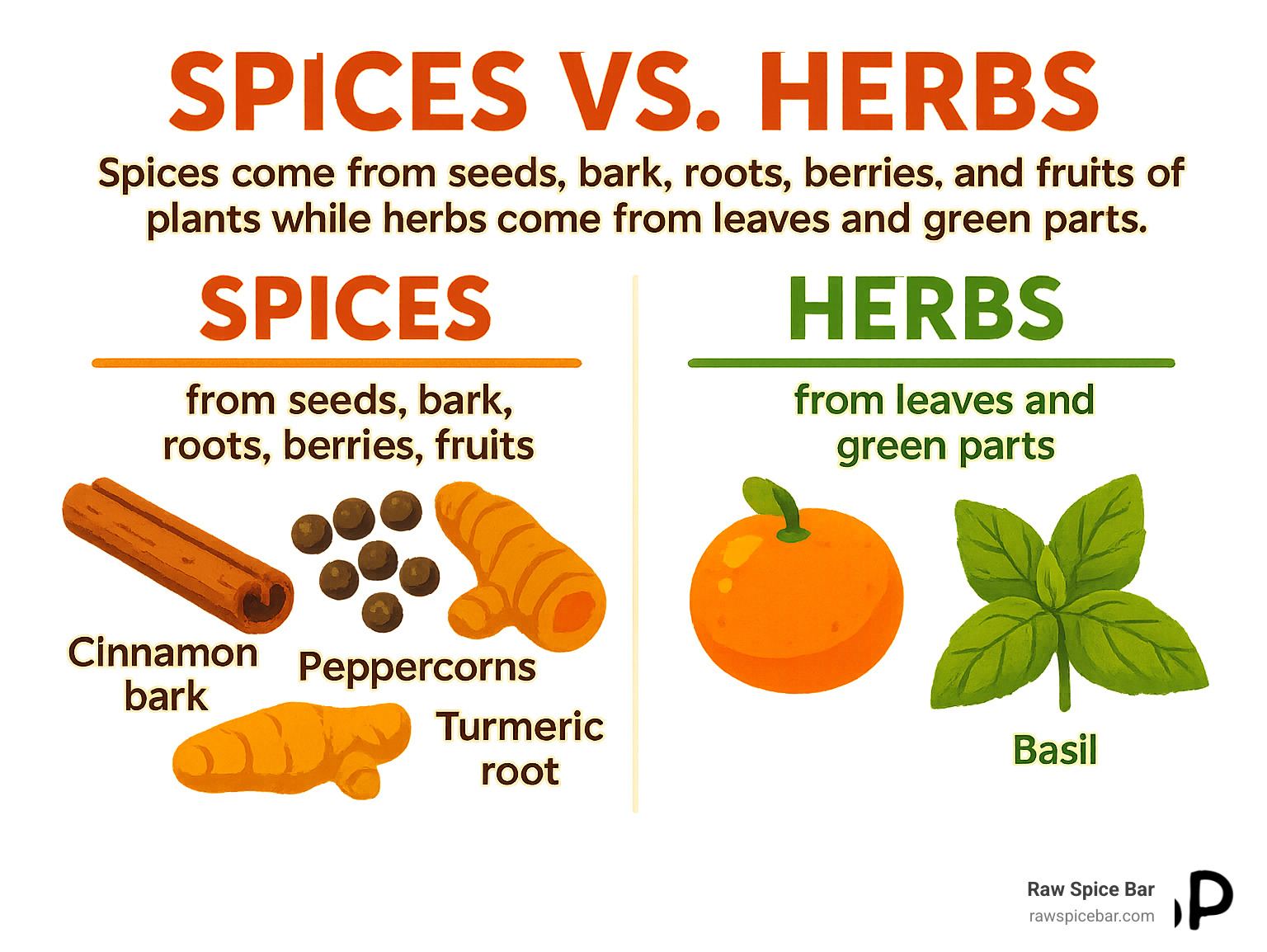
What Are Spices and How Do They Differ From Herbs?
Spices come from the seeds, bark, roots, or berries of plants; herbs are the tender leafy parts. Because spices grow in tougher tissue, they pack far more essential oils, last longer, and tolerate heat better than herbs.
• Crack peppercorns or grate cinnamon bark and you’ll see why a tiny amount perfumes the whole kitchen.
• Fresh basil, by contrast, wilts fast and tastes grassy if cooked too long.
Classic cooking relies on both: bay leaves (an herb used like a spice) simmer with dried thyme in a bouquet garni; bright parsley gets sprinkled on at the end for freshness.
Whole-Plant Snapshot
• Cinnamon bark – sweet-woody quills that keep their aroma for years.
• Coriander seeds – dried fruit of the cilantro plant; warm, citrus-nutty.
• Turmeric root – earthy, vividly yellow, health-boosting curcumin.
• Allspice berries – taste like cinnamon, nutmeg & cloves in one.
Why Bother?
Spices lift flavor, add color, cut sodium, and even deliver antioxidants – turmeric’s curcumin and cinnamon’s blood-sugar support are two celebrated examples. More importantly, they’re edible postcards from Mexico, Morocco, India, and beyond. Learning how to use spices lets you travel the world without leaving the stove.
How to Use Spices: The Basics
Stock about 15 essentials (black pepper, cumin, paprika, turmeric, cinnamon, chili powder, garlic powder, ginger, nutmeg, coriander, cardamom, bay leaves, oregano, thyme, red-pepper flakes). Buy small jars, keep them cool, dark, and airtight, and date the lid the day you open them.
Shelf life cheat-sheet: whole = 18 months, ground = 6 months. To test potency, rub a pinch between your fingers – no aroma means no flavor.
Picking the Right Spice
Start with one bold + one mild. Cumin + coriander for tacos, cloves + allspice for baking. Borrow time-tested regional sets: oregano-thyme-rosemary for Mediterranean, turmeric-coriander-cumin for Indian, chili-oregano-cumin for Mexican.
Safe & Simple Rules
- Season lightly, taste often.
- When doubling a recipe, bump spices only 1.5×.
- Mind allergies or extra-spicy heat; dairy can cool capsaicin burn.
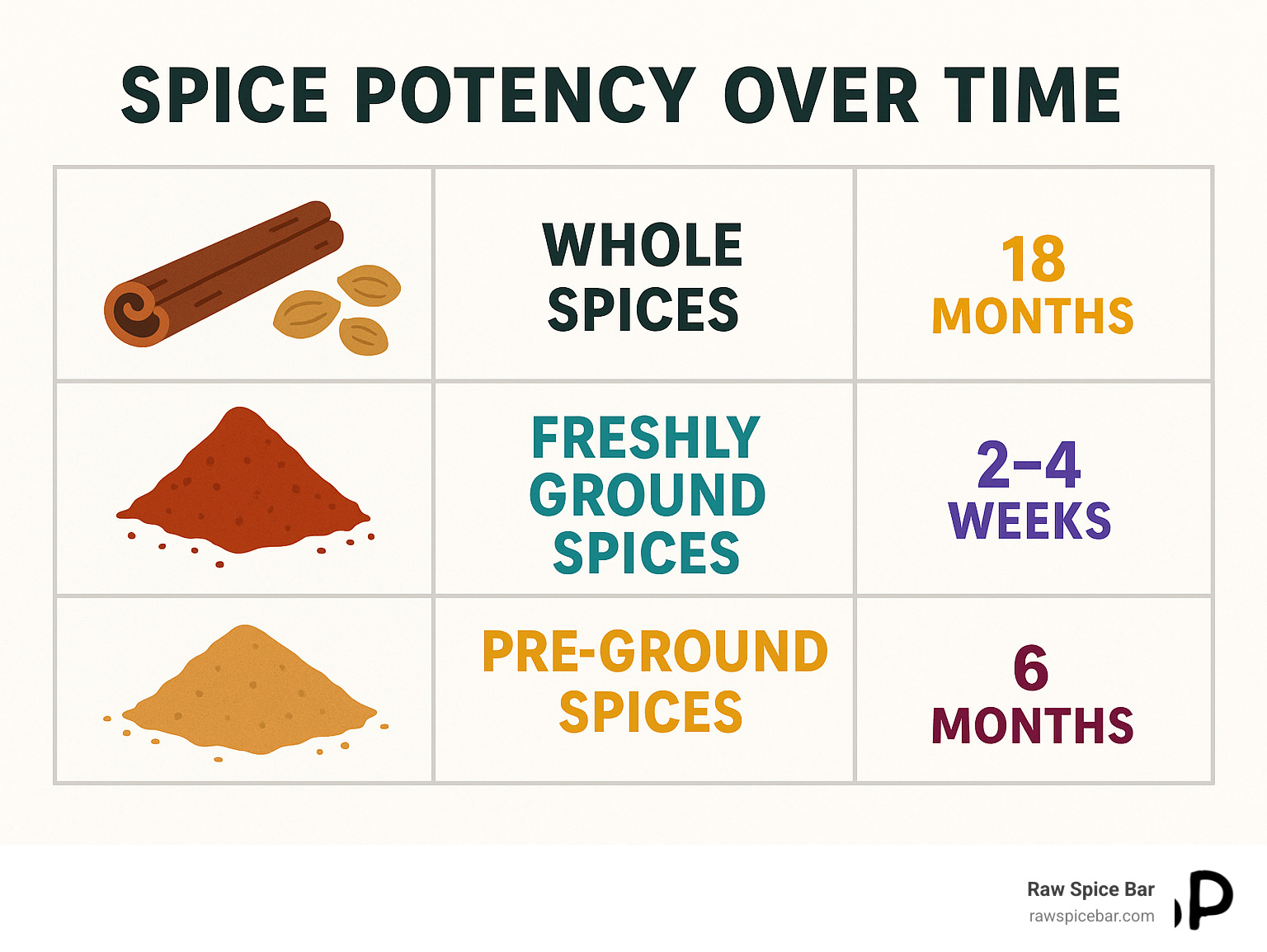
Flavor-Boosting Techniques Every Cook Should Master
Three moves open up maximum flavor:
- Toast – warm whole or ground spices in a dry pan 30-90 sec until fragrant.
- Bloom – sizzle ground spices in a little oil 15-30 sec to season the fat.
- Grind fresh – use a mortar-pestle or coffee grinder; clean with a chunk of bread between batches.
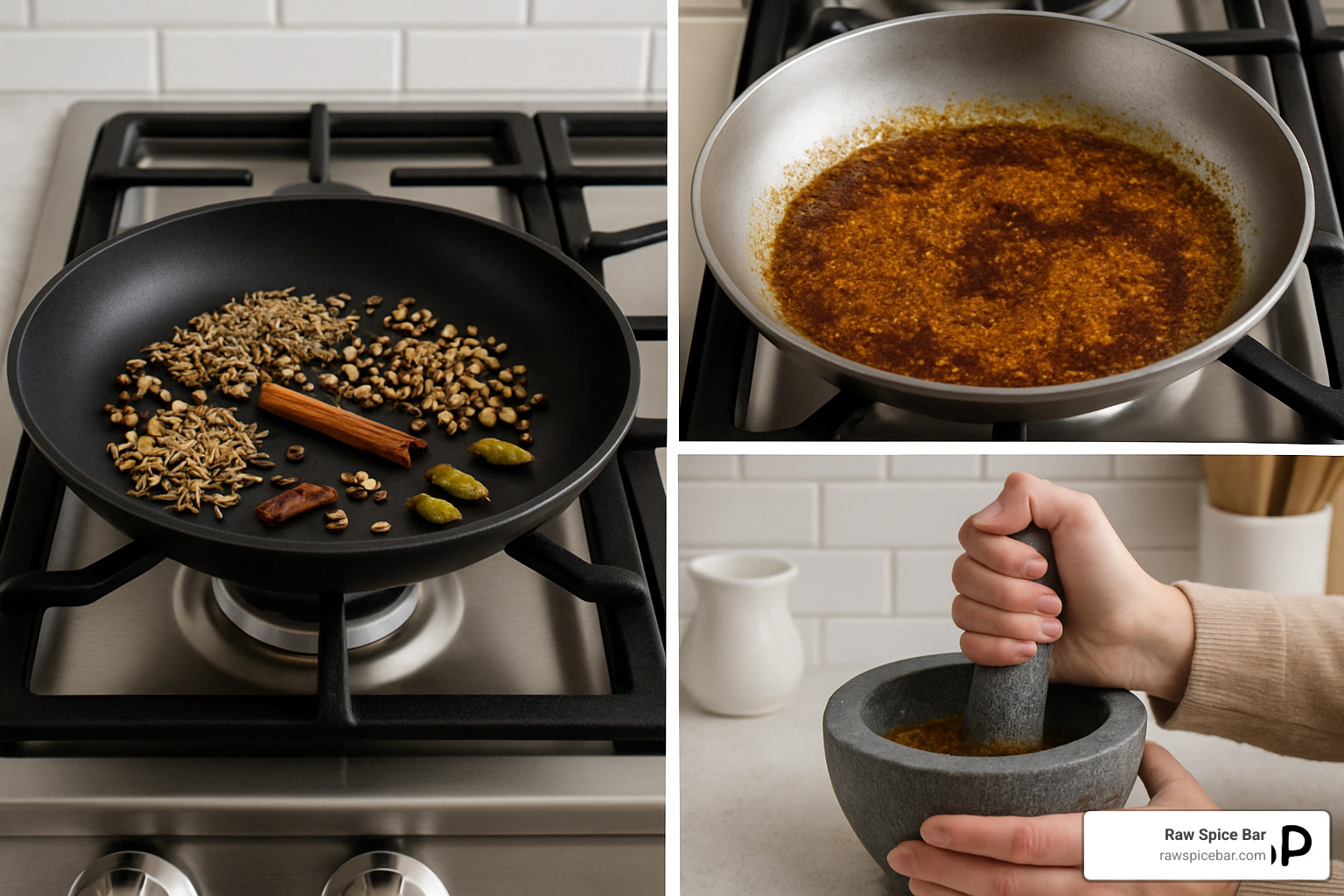
Layering
• Base: bay leaves, peppercorns, cinnamon sticks early.
• Mid-cook: cumin, turmeric, paprika halfway.
• Finish: cracked pepper, smoked paprika, chili flakes just before serving.
DIY Blends in Seconds
Follow 3 : 2 : 1 – three parts main flavor, two parts support, one part accent. Keep them salt-free so you can season each dish to taste later.
A Global Roadmap of Classic Spice Combinations
Learning how to use spices is easier when you copy proven regional trios:
• India – Garam Masala: cardamom, cinnamon, cloves, coriander, cumin.
• Mexico – Taco Trinity: cumin, oregano, chili powder.
• Mediterranean – Herbes Mix: oregano, thyme, rosemary, bay.
• Morocco – Ras el Hanout: turmeric, ginger, cinnamon, rose, more.
• Japan – Shichimi: sesame, chili, nori, citrus peel.
• Ethiopia – Berbere: fenugreek, paprika, cayenne, allspice.
• China – Five-Spice: star anise, fennel, cinnamon, cloves, Sichuan pepper.
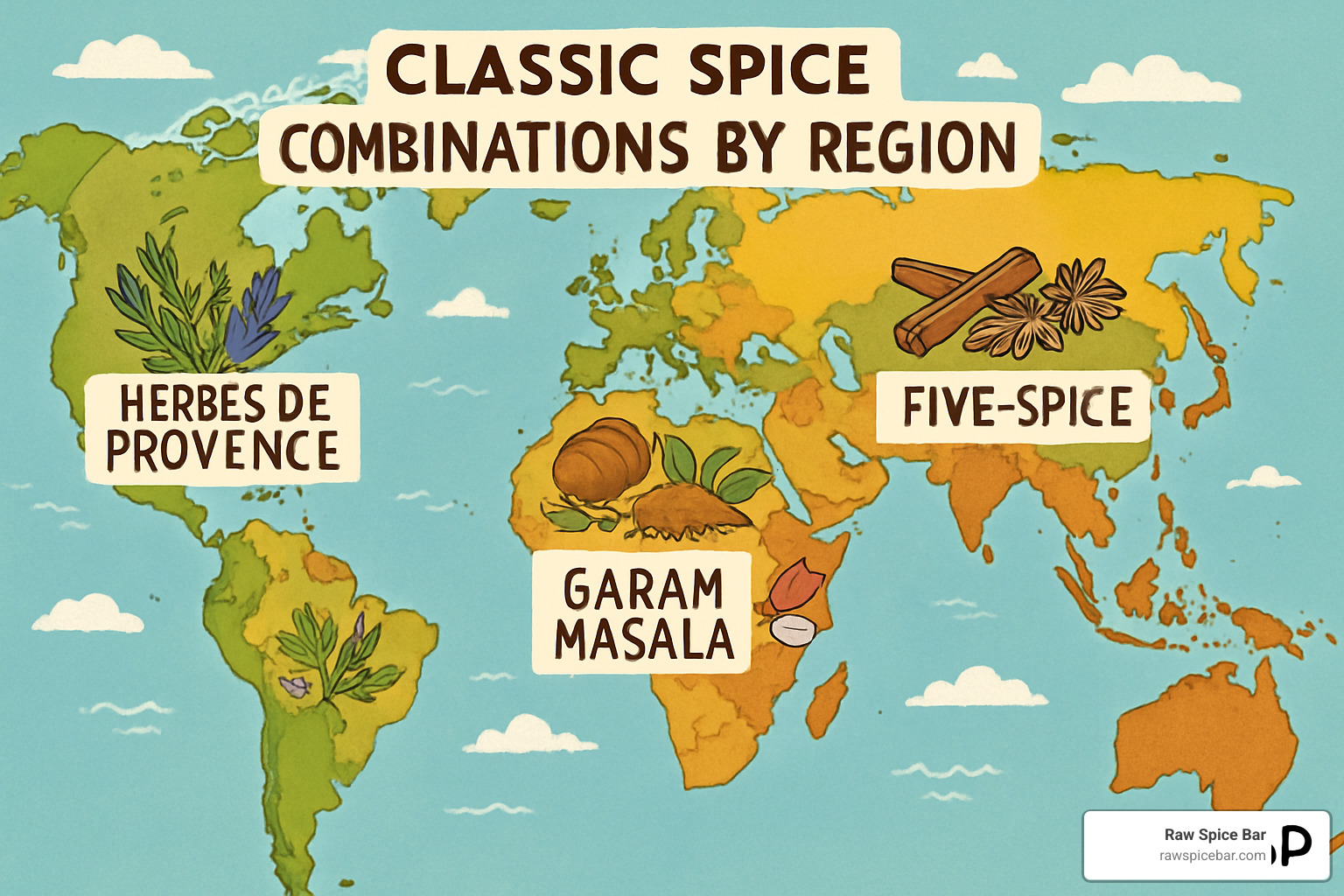
Eleven Pantry Staples
Black pepper, cumin, smoked paprika, turmeric, cinnamon, chili flakes, garlic powder, ginger, nutmeg, bay leaf, cardamom. With these you can riff on almost any cuisine.
Health, Shelf Life & Common Mistakes
Spices aren’t just tasty – many are antioxidant and anti-inflammatory powerhouses – but only while they’re fresh. Heat, light, and humidity erase both flavor and benefits.
Common pitfalls and fixes:
• Storing by the stove – move to a cool, dark cabinet.
• Buying giant jars – purchase 1-3 oz at a time.
• Adding delicate spices too early – save cinnamon or nutmeg for the end.
• Over-spicing – start small; you can’t un-season.
Whole vs. Ground
Whole spices = slow-release (stocks, braises). Ground = instant flavor (sauté, rubs). Grind whole just before cooking for the best of both worlds.
When Are They Done?
Ground: 6 months | Whole: 18 months. If color has faded or aroma is weak, compost the old jar and treat yourself to a fresh refill.
Frequently Asked Questions about How to Use Spices
These are the questions I hear most often from home cooks who are just starting their spice journey. Don't worry - we've all been there, staring at our spice rack wondering where to begin!
What's the easiest way to start experimenting?
The secret to building confidence with spices is to start with familiar flavors and gradually expand your comfort zone. Think about spices you already enjoy in restaurant dishes or packaged foods, then try incorporating them into your home cooking.
Begin with simple, low-risk experiments. Add a pinch of cinnamon to your morning coffee for warmth, sprinkle cumin into scrambled eggs for an earthy twist, or dust smoked paprika over roasted vegetables for a gorgeous color and subtle smokiness. These small additions won't overwhelm your dish but will help you understand how each spice behaves.
The golden rule when learning how to use spices is to start small and taste as you go. You can always add more, but you can't take it back once it's stirred in. Keep a small spoon nearby for tasting throughout the cooking process - this builds your palate and teaches you how flavors develop over time.
Can I substitute dried herbs for fresh spices?
This is where things get a bit tricky, and understanding the difference will save you from some kitchen disasters. When substituting fresh herbs for dried herbs, use a 3:1 ratio - three tablespoons fresh equals one tablespoon dried. This works because dried herbs are more concentrated than their fresh counterparts.
However, spices and herbs serve completely different functions in cooking, so direct substitutions don't always work. Spices tend to be more intense and come from different parts of the plant, while herbs are typically milder and come from leaves. You wouldn't substitute oregano (an herb) for cumin (a spice) and expect the same flavor profile.
Instead of exact replacements, focus on complementary flavors that serve similar purposes in the dish. If a recipe calls for fresh basil but you only have dried oregano, think about what role the basil plays - is it adding freshness, earthiness, or aromatic qualities? Then choose your substitute based on that function rather than trying to match the exact flavor.
How do I fix a dish that's over-spiced?
We've all been there - you get a little heavy-handed with the cayenne, and suddenly your family dinner feels like a fire-breathing contest. Don't panic! There are several ways to rescue an over-spiced dish.
Dilution is your first line of defense. Add more of the base ingredients like vegetables, grains, rice, or protein to spread the spice concentration across more food. This is often the most effective solution because it maintains the dish's intended flavors while reducing intensity.
For dishes that are too spicy-hot, dairy products work wonders. Stir in yogurt, sour cream, or cream to cool the heat. The proteins in dairy actually bind to capsaicin (the compound that makes peppers hot) and neutralize the burning sensation. A dollop of plain Greek yogurt can save an overly spicy curry.
Sweet ingredients like honey, sugar, or even a touch of maple syrup can balance excessive spice by creating flavor harmony. This works particularly well when you've added too much of a bitter or pungent spice like turmeric or fenugreek.
In extreme cases where the dish is truly beyond rescue, start over with a fresh batch and combine the two. Make a completely unseasoned version of the same dish, then gradually mix in the over-spiced portion until you reach the perfect balance. It might seem like extra work, but it's better than wasting the entire meal or suffering through an inedible dinner.
Conclusion
Learning how to use spices effectively is like finding a secret language that transforms your entire relationship with cooking. What once felt like following rigid recipes becomes an exciting creative trip where you're the artist mixing flavors like paint on a canvas.
The techniques we've covered - from proper storage and toasting methods to understanding global flavor combinations - give you the foundation to cook with genuine confidence. You now know that freshly ground spices make all the difference, that whole spices last longer than ground ones, and that a simple toast in a dry pan can awaken flavors you never knew existed.
But here's the beautiful truth about spice mastery: it comes through practice, not perfection. Every time you bloom cumin in oil and smell that earthy aroma fill your kitchen, you're building your culinary instincts. When you create your first custom spice blend using that 3:2:1 ratio, you're stepping into the role of flavor artist.
Don't worry about making mistakes along the way. Over-spicing a dish teaches you restraint. Burning garlic in oil shows you the importance of temperature control. These "learning moments" are actually victories disguised as setbacks - they're building your intuition for how to use spices in ways that no cookbook can teach.
At Raw Spice Bar, we've watched thousands of home cooks transform their kitchens into global flavor destinations. Our monthly subscription delivers freshly packed spices with seasonal recipes and educational content, making it easy to explore new techniques and combinations each month. There's something magical about opening a package of aromatic spices and knowing you're about to create something special.
The world of spices offers endless possibilities for culinary creativity. Whether you're recreating the warm comfort of your grandmother's cinnamon rolls or boldly experimenting with Ethiopian berbere, you now have the knowledge to make every dish sing with flavor. More recipes and inspiration await as you continue this delicious journey of findy.
Your spice trip is just beginning, and every meal is an opportunity to practice these skills and build your confidence. Trust your taste buds, accept the process, and remember - the best dishes come from cooks who aren't afraid to season boldly and taste fearlessly.


